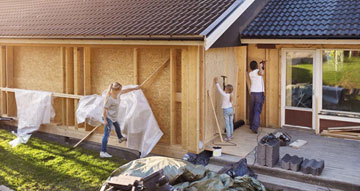We need more houses. It’s going to take a long time until we have enough.
Check out what happened during and after the housing bust that began in 2008: Single-family house construction cratered. House completions have recovered a bit since 2011, but they’re barely above the depths of the 1982 recession.
A tale of 2 booms
 OK, fine, so the average for the last 50 years is 1.4 million permits. But that doesn’t take population booms into account. When you look at the graph above, you can see the effect of the postwar baby boom. Building permits rose abruptly beginning in 1971, when the 1st Baby Boomers turned 25. There was a recession, and then building permits zoomed upward again and peaked in 1978, when the oldest Boomers were 32.
OK, fine, so the average for the last 50 years is 1.4 million permits. But that doesn’t take population booms into account. When you look at the graph above, you can see the effect of the postwar baby boom. Building permits rose abruptly beginning in 1971, when the 1st Baby Boomers turned 25. There was a recession, and then building permits zoomed upward again and peaked in 1978, when the oldest Boomers were 32.
Now the Millennials are aging into the home buying years. The Millennials’ peak birth year was 1990, when 4.18 million children were born in the United States. In a few years, huge numbers of them will want to buy brand-new houses. They’re having children later than the Boomers did, so their peak home buying years will be later in life, too.
“If we assume that the housing stock is in balance with households and needs, then we should be seeing new construction deliver the units necessary to house the new households being formed and to replace housing stock lost (lost to disaster, dilapidation or teardowns and re-development),” Smoke wrote.
He continued: “Last year, we saw a net increase of 1,358,000 households. … We only completed 968,000 homes. We don’t have a corresponding exact figure for housing stock loss, but a conservative estimate is that 300,000 homes were lost last year. That would mean that the net addition to the housing stock was less than half of what the increase in households warranted.”
That’s 1 of the reasons that rents and home prices are rising fast in a lot of metro areas.
“We need more construction to keep pace with demand, but if we don’t see it, rents and prices will continue to rise,” Smoke said. “Eventually that leads to declining affordability that could dampen job and household growth.”
Places with acute shortages
The National Association of Realtors has been pounding the table recently about the slow pace of home construction. This week the association released a list of the top 10 metro areas with the biggest need for single-family housing starts. It began with the premise that, historically, 1 house is built for every 1.6 jobs created. Then the association looked at job creation in 171 metro areas from 2013 through 2015. Finally, it calculated how many houses would have to be built in each metro area to get back to that ratio of 1 new house for every 1.6 new jobs. Then it came up with a list of the metro areas that need the most new houses.
10 markets with biggest
shortages
1. New York (218,541 permits required)
2. Dallas (132,482 permits required)
3. San Francisco (127,412 permits required)
4. Miami (118,937 permits required)
5. Chicago (94,457 permits required)
6. Atlanta (93,627 permits required)
7. Seattle (73,135 permits required)
8. San Jose, California (69,042 permits required)
9. Denver (67,403 permits required)
10. San Diego (55,825 permits required)
I have quibbles with this – there’s no room to build single-family houses in New York City, and having spent most of my childhood in an apartment in Fort Worth, I think the Metroplex has more apartment complexes than other places I’ve lived. But I agree with the broader point made by Lawrence Yun, chief economist for the National Association of Realtors: “Without the expected pick-up in building as job gains rose in recent years, new and existing inventory has shrunk, prices have shot up and affordability has eroded despite mortgage rates at or near historic lows.”
Not enough construction workers
The construction industry says it faces 2 main problems: A lack of buildable lots (often made worse by strict zoning and building codes) and a dearth of construction workers.
In a paper called “Where Did All the Construction Workers Go?,” a pair of Census researchers said last year that 60% of construction workers displaced by the housing bust were employed by other industries or had stopped working by 2013. Meanwhile, during the downturn, construction companies were slow to hire younger workers ages 19 to 24.
“One reason for this decline could be unwillingness by construction companies to train relatively young workers relative to other industries in the economy,” wrote Hubert Janicki and Erika McEntarfer. “Another reason for this decline could be unwillingness to hire or work for short-duration contract jobs.”
Whatever the reason, it means fewer young workers gained experience in the industry. That’s not going to end well.
Youngest and oldest counties
Speaking of age, the Census put out a list of the nation’s counties with the youngest and oldest median ages. Unsurprisingly, the oldest county – by far – is in Florida. It’s Sumter County, home of a fast-growing city-slash-retirement community called The Villages. Returning home from a trip to the mountains a few years ago, I rode my motorcycle through The Villages. The traffic was as bad as Atlanta’s, except the drivers were older. I have avoided riding or driving through The Villages ever since.
Holden Lewis
-Courtesy Bankrate






